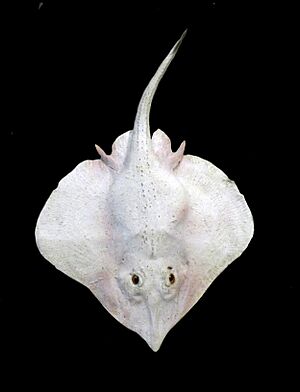Pacific white skate facts for kids
Quick facts for kids Pacific white skate |
|
|---|---|
 |
|
| Conservation status | |
| Scientific classification | |
| Synonyms | |
|
The Pacific white skate (Bathyraja spinosissima) is a fascinating type of skate, which is a flat fish related to sharks. It lives in the deepest parts of the ocean, much deeper than most other skates! You can find it at depths from 800 to almost 3,000 meters (that's like 2,600 to 9,500 feet) on the continental slope, which is the steep drop-off from the edge of continents into the deep sea. This amazing creature calls the southeast Pacific Ocean home, from the Galapagos Islands all the way up to the coast of Waldport, Oregon. Scientists even found its egg cases and baby skates near the Farallon Islands off San Francisco. In 2023, a huge "nursery" (a place where baby skates grow) was discovered off the Pacific coast of Canada.
Contents
What Does the Pacific White Skate Look Like?
The Pacific white skate has a flat, diamond-shaped body, called a disc, which is a bit wider than it is long. Its disc has rounded tips, making it look smooth. The entire disc is covered with many tiny, tooth-like bumps called denticles. These give its skin a rough, sandpaper-like feel. Adult male skates have special spines on their pectoral fins, which are near the tips of their "wings."
Tail and Fins
The skate's tail is a little longer than its body disc. It has a single row of 23 to 29 thorns running down the middle of its tail. Near the end of its tail, it has two dorsal fins that are about the same size. There isn't a thorn between these two fins. The very end of its tail is long and thin, with a small fold on top.
Teeth and Color
The Pacific white skate has many teeth! It has 34 teeth in its upper jaw and 23 in its lower jaw. Its color is usually a pale or salty gray, both on its top and bottom. The edges of its disc are a bit darker.
Life Cycle and Diet
The Pacific white skate eats benthic fishes. This means it hunts fish that live on or near the seafloor. Like other skates, it is oviparous, which means it lays eggs. The egg cases are olive green and have long stripes. They also have horn-like parts on their shell.
Growth and Size
When a baby skate hatches, it is about 25 centimeters (10 inches) long. Adult female skates can grow to be quite large, up to 2 meters (6.5 feet) long! People don't usually fish for Pacific white skates for food. However, they are sometimes caught by accident by fishing boats.
Warm Water Nurseries
Scientists have found skate nurseries in warm areas near volcanoes. This suggests that the warm water helps the eggs develop faster. This might mean more baby skates survive and grow up successfully.
Amazing Discoveries
The name spinosissima comes from a Latin word meaning "thorny." This name refers to the many small, thorny denticles that cover the skate's skin.
Galápagos Nursery
In 2018, scientists found many bag-shaped eggs near hot underwater vents close to the Galápagos Islands. This discovery suggested that mother skates were using the warmth from these volcanic areas to help their eggs hatch. It's like a natural incubator!
Canada's Giant Nursery
In 2023, a team of scientists went to explore what they thought was an extinct volcano off the Pacific coast of Canada. To their surprise, they found that the volcano was still active! Even more amazing, they discovered that the area was covered by hundreds of thousands of Pacific white skate eggs. This newly found nursery was much, much larger than the one near the Galápagos Islands. The eggs they found were also very big, measuring about half a meter (1.5 feet) across!


